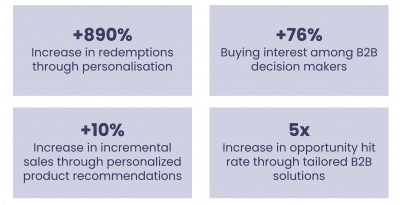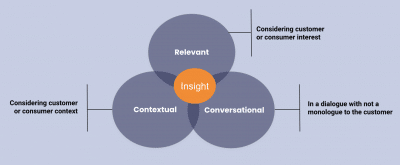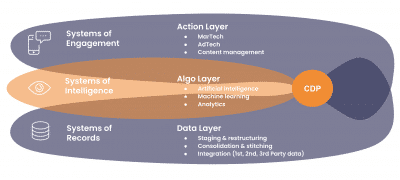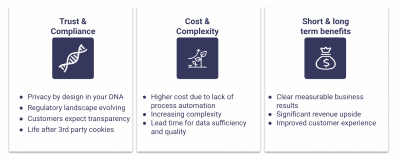You’re not alone if you’ve recently heard a lot about Customer Data Platforms (CDPs) and how they can help companies understand and act on data better. Continue reading to learn how a CDP may help you deliver a personalised customer experience that is no longer a “nice to have” but rather an expectation.
Why is Personalisation Important?
Customer-centricity is a strategy and a culture that focuses on creating the best possible customer experience while also increasing brand loyalty. Whether on the B2B or B2C side, a client-centric business ensures that the customer is at the centre of a company’s decision-making, ideas, and operations.
According to actual client references and results at Avaus (see ex.1): personalising the customer experience has a significant business impact as we see an actual sales uplift on the consumers’ side when it comes to activities such as; redemptions as well as product recommendation. We also notice that effective personalisation has an impact on buying interest among B2B decision-makers as well as opportunity hit rates & velocity.

Exhibit 1: Actual Avaus Client References and Results
Personalisation is more than just about generating a business result; it’s an expectation by the consumers to give a more realistic customer experience and make them feel like they are being heard and understood independently. The importance of personalisation is easiest to grasp when you think of your own experience as a consumer.
“73% of customers expect companies to understand their needs and expectations, and 45% of customers ignore communications from companies unless they are personalised for them”. – Salesforce, State of the Connected Customer, 2019.
For more interesting and recent numbers, check the report from 2023 here.
What is Personalisation, After All?
Personalisation can have three main qualities:
- Relevant: The right individual products or solutions. Considering customer or consumer interests means targeting personas’ and segments’ respective needs with tailored solutions or offers. 91% of consumers surveyed say they are more likely to shop with brands that provide offers and recommendations that are relevant to them.
- Contextual: The right information at the right time and place. Considering customer or consumer context means understanding the sales cycle or buying journey stage, touchpoints, and previous interactions. 87% of consumers surveyed say that personally relevant branded content positively influences how they feel about a brand.
- Conversational: A dialogue, not a monologue to the customer, meaning from generic campaigns to ongoing individual, timely interactions. Consumers are 40% more likely to view items that are recommended based on the information they’ve shared with the brand.
All three features revolve around one core theme: insight. With data growing, marketing automation maturing, and artificial intelligence coming into its own, personalisation has risen to the level of 1 to 1 – meaning one business to one consumer.
Marketers struggle to navigate the growing landscape of technology. In an attempt to overcome data silos and create a single customer view, CDPs emerge as a solution.

Exhibit 2: Three main qualities
What is a Customer Data Platform?
“A customer data platform is a marketing system that unifies a company’s customer data from marketing and other channels to enable customer modelling, and optimise the timing and targeting of messages and offers” – What Data and Analytics Leaders Need to Know About Customer Data Platforms – Gartner, 2020.
The more data you have, the more you can get out of it? In practice, “the information about the customer has often been lost in a large lake of data, requiring IT personnel to work on it and dig for information. Customer data may have been rendered practically worthless or untrustworthy at times due to data quality challenges or unclear data definitions, and marketers may not have been able to effectively use all of the data the company had access to”. – Tuukka Valkeasuo, Group CTO at Avaus.
This is where the Customer Data Platforms came into play. CDPs solved this problem by offering a unified customer view that gathers a companies’ first-party data into a single, comprehensive platform.
“Data lake should be rather seen as one piece of the puzzle, not the full solution and when talking about CDP; CDP is about a concept rather than one product or one technology”. – Steven Biehl, managing director DACH at Avaus.
There is no single correct set of capabilities or functionalities in what CDP has or can do. Sometimes, companies can become overwhelmed by the concept of customer data or the customer 360-degree view. “Organisations often pursue a 360-degree customer view that sets wildly unrealistic expectations for collecting, normalising, and maintaining every scrap of available customer data”. – Gartner 2019.
This has been a challenge for data and analytics leaders to understand that a CDP does not contain all of the customer data, but only the data required by the use-cases are present – and that it’s still possible to build powerful use-cases with a surprisingly minimal amount of data. However, the CDP could be expanded according to the business targets, needs, and use-cases requiring a larger amount of data.
Watch AET 5: Best Practices & Use Cases
CDP Data Integration
Many companies will likely have a part of CDP already in place. “many organisations that are implementing CDPs already have significant data repositories and data infrastructures at their disposal. They often have enterprise data warehouses, data lakes or master data management systems.” – What Data and Analytics Leaders Need to Know About Customer Data Platforms – Gartner, 2020.
Generally, there are three layers of technology capabilities (see ex.3): a system of records where your data is provided and integrated. Then you have a system of intelligence that is eventually providing algorithms, and on the top, there is a system of engagement where you find your marketing technology and CRM.
In a very simplified view (see ex.3), you might place a CDP between the data layer and action layer as it connects the two layers and enables us to deal with the data we’ve integrated and recorded and then interprets it and turns it into something more actionable.
Developing a CDP capability is often done in phases, based on the use cases with most business value. You can start with simple CDP components that might serve the need of integration and consolidating your customer profile, leaving the whole artificial intelligence and machine learning piece for the future as you can build it up step by step instead of having to buy the full stack from the beginning.

Exhibit 3: Three Layers of Technology Capabilities
You’re working with many legacy systems; instead of painting yourself into yet another corner, this solution should enable you to build new capabilities and grow gradually. This is one underlying requirement you should consider for your use-cases: how will you scale this once you’ve completed the first ten, and how will you build the next hundreds?
CDP selection support for Telia Sweden
3 Reasons to Start Building CDP Now
Customer data is the air in your business’s lungs. Owning your own customer data systems allows you to understand your customer better than your competitors and take action on that information faster. Here’s why you should start building it now:
Trust and Compliance: You need to keep in mind that it’s important to build trust with your customers. It should be privacy by design thinking, focusing on trust and transparency. This is easier to consider in the beginning rather than building more capabilities and then putting them in place.
Cost and Complexity: The sooner you start establishing some of the core data structures in place, such as centralising your core key customer data and connecting your activation or engagement systems to it, the less likely you will construct something that will become redundant in the future. The sooner you can place data and make use of AI, machine learning, and data availability, the more data you’ll have to work with in the future.
Short and Long Term Benefits: Some benefits, particularly when it comes to CDP, might be a little further down the road as it needs to be enough data to use it efficiently. However, there are some use-cases where you will see immediate results, either visible to a customer as a relevant messaging or improved visibility for decision-makers.

Figure 3: Three reasons to start building CDP capabilities
Use Our Resources to Take Your First Step
Our complimentary Avaus Expert Talks 5 explores a set of approaches such as; in which stage of your transformation (customer) data capabilities will become relevant, which use cases typically are the initial ones, to begin with for rapid time to value, last but not least, how these capabilities will affect your current architecture and roadmap.
Go to All Downloadables